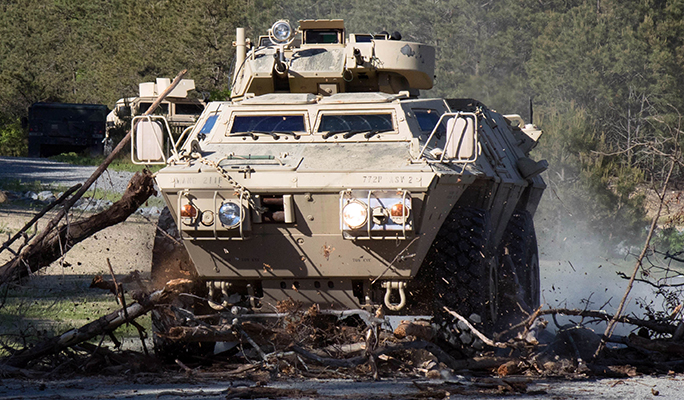
Training and evaluating Army National Guard combat support capabilities was the focus of a week-long combined arms exercise on Cape Cod, Massachusetts, from June 6 through June 11, 2018. Operation Patriot Crucible was the most complex exercise of this nature ever to take place at Camp Edwards here.
Camp Edwards is the largest military training facility in New England with 15,000 total acres dedicated to Army maneuver areas and training ranges. Patriot Crucible used that space to provide round-the-clock training to ten units of the Massachusetts Army National Guard consisting of 438 soldiers and 120 vehicles.
“We are primarily focusing on the enabling units. They are the primary audience,” said Army Lt. Col. Matthew Porter, the exercise director for Patriot Crucible. “That is the uniqueness of this exercise.”
According to Porter, large scale training events featuring maneuver units such as infantry or armor are common for the U.S. military. By removing those maneuver units, Patriot Crucible concentrated resources on assessing and improving the ability of the troops responsible for supporting the frontline warfighter.
“The essence of the exercise is we are combining these types of units, whether it is transportation, engineers, chemical, or military police all together,” said Porter.
Military intelligence, fire fighter and explosive ordinance disposal soldiers also participated in Patriot Crucible.
“The best thing about Camp Edwards is the varied terrain on the installation. You go from gentle, flat rolling hills to highly challenging, densely forested areas that cause maneuver challenges for units, so there is a wide variety of space,” said Army Capt. Alexander McDonough, the Range Safety Officer for Camp Edwards.
The premise for Patriot Crucible was that an infantry brigade was conducting an offensive operation against a well-equipped, modern enemy. The support elements were trailing the brigade and, in doing so, providing continuous support to the combat operations, while also providing their own security. That mission became increasingly difficult as the exercise directors introduced additional events into the scenario.
All of the training units started the exercise at a large, authentic combat outpost permanently installed at Camp Edwards. From there the various training units conducted tactical convoys to more austere locations in the training area where they then established three different Brigade Support Areas. The convoys took place during both day and night. Along the convoy route, the units encountered several obstacles including debris barriers, hostile civilians and improvised explosive devises.
“The convoy lane was a challenging land navigation course. It was a difficult route and that was on purpose,” said Army Maj. Joel Simpson, who managed the observer controllers responsible for assessing the training units. “More training still needs to be done, but the units seemed motivated and ready to get training done.”
Once the units were set in their Brigade Support Areas, they became subject to random harassment by criminal elements and enemy insurgents operating behind the lines. There were also random incidents of indirect fire accompanied by chemical or biological agents.
Throughout the exercise, the participating units improved their positions. Heavy engineers used bulldozers to dig defilade fighting positions and defensive tank ditches. Horizontal engineers laid gravel and asphalt roads to improve movement options. Truck drivers moved and emplaced obstacles to inhibit attacks.
A Special Forces team and aviation assets also participated throughout the week. Operational Detachment team 2132 conducted a surgical raid to capture an enemy officer at the Camp Edwards urban terrain site. They inserted into the site using a technique known as “fast roping” wherein the soldiers slide down a rope from a hovering helicopter.
Immediately after that raid, the rest of the training units were informed of a simulated helicopter crash. Army fire fighters scrambled to the location of the crash where a blazing fire surrounded an inverted car representing the downed helicopter. The fire fighters had to extinguish the flame and extract the passengers. Earlier in the exercise, the same firefighting detachments had been called upon to rescue life-size dummies from cars crushed by large cement blocks.
“This is essential training to prepare the Army’s combat support formations to win in complex future conflicts,” said Army Col. Tim Watson, the Active Component Advisor to the Massachusetts National Guard and a former Brigade Commander in the 82nd Airborne Division. “This ambitious exercise is exactly the type of training senior Army leaders have directed to increase combat proficiency across the Army.”
The Massachusetts National Guard and the staff at Camp Edwards plan to build upon Patriot Crucible 2018 in future years. The next combined arms exercise hosted at Camp Edwards is likely to involve more units, more soldiers, more missions; and less sleep.








